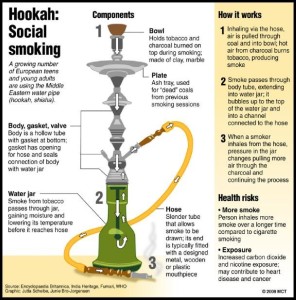 According to the American Lung Association, hookah is a water pipe used to smoke a kind of tobacco called shisha. Shisha comes in different flavors and is also called nar-ghile, argileh, shisha, hubble-bubble, and goza. Hookah use began centuries ago in ancient Persia and India. Today, hookah cafés are gaining in popularity around the world, including Britain, France, Russia, the Middle East, and the United States. Hookah smoking is typically practiced in groups with the same mouth piece passed from person to person.
According to the American Lung Association, hookah is a water pipe used to smoke a kind of tobacco called shisha. Shisha comes in different flavors and is also called nar-ghile, argileh, shisha, hubble-bubble, and goza. Hookah use began centuries ago in ancient Persia and India. Today, hookah cafés are gaining in popularity around the world, including Britain, France, Russia, the Middle East, and the United States. Hookah smoking is typically practiced in groups with the same mouth piece passed from person to person.
Hookah use by youth and college students is increasing. In 2010, the Monitoring the Future survey found that among high school seniors in the United States, about 1 in 5 boys (17%) and 1 in 6 girls (15%) had used a hookah in the past year.
While many hookah smokers may think this practice is less harmful than smoking cigarettes, hookah smoking has many of the same
health risks as hookah smoking delivers nicotine, the same highly addictive drug.
Because of the way a hookah is used, smokers may absorb more of the toxic substances also found in cigarette smoke than cigarette smokers do. An hour-long hookah smoking session involves 200 puffs, while smoking an average cigarette involves 20 puffs. (American Lung Association, 2007).
The amount of smoke inhaled during a typical hookah session is about 90,000 milliliters, compared with 500–600 ml inhaled when smoking a cigarette (American Journal of Health Behavior, 2010). In addition, sharing the same mouth piece also increases the risk of infections such as herpes. Younger teens are more likely to use hookah sticks which come in brightly colored pen shapes and have flavors that appeal to children and teens, have high levels of nicotine, and can sell for under six dollars.
Resource: Patty Warble, Parenting for Prevention
